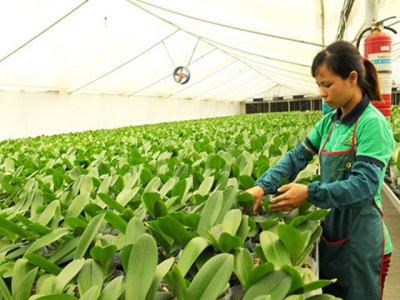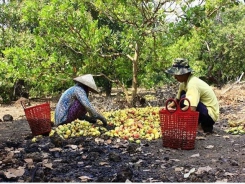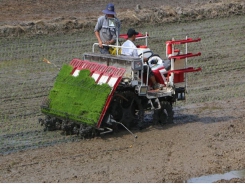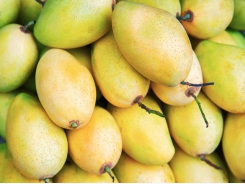Hà Nội helps bring farmers into 21st century with tech

HÀ NỘI — Nguyễn Đức Dần, chairman of the Ba Trại Commune People’s Committee, cannot hide his happiness as he discusses his community’s strides in tea production.
A worker tends to orchids in a greenhouse at a farm in Hà Nội. The greenhouse is equipped with automatic watering and temperature control systems to boost production. — Photo Courtesy of the Hà Nội Department of Agriculture and Rural Development
Dần said tea production has been rising, boosting the incomes of local farmers making the commune the most important tea planting area in Hà Nội’s Ba Vì District with a total cultivated area of 560ha.
In 2014, the commune received technical help from the Hà Nội Department of Agriculture and Rural Development to plant tea that meets Vietnamese Good Agriculture Practice (VietGAP) standards, which ensure a high level of standardised quality through the use of modern farming techniques. Local farmers were taught methods to update their ineffective old farming techniques.
For example, farmers like Dần who elected to apply VietGap standards were trained to a use new, more efficient watering system and to harvest using machines instead of manually.
Since then, tea production has gradually risen.
On average, each hectare of tea in the commune brings in about VNĐ220 million (US$9,400) of profits per year, as much as twice the profit generated by conventional farming techniques.
Director of the municipal Department of Agriculture and Rural Development Chu Phú Mỹ said Hà Nội has targeted increasing the amount of agricultural production that uses hi-tech practices from 25 per cent of all agricultural areas last year to 35 per cent by the end of this year.
Hà Nội has applied biotechnology, new cultivation and preservation methods and automation to its agricultural production, according to the municipal Department of Agriculture and Rural Development.
Mỹ said it would also urge localities to complete programmes to set up new-style rural areas.
In addition to its hi-tech push, the municipal agricultural sector has also allowed farmers to import livestock from other countries to raise productivity.
Farmers have imported chickens from the Czech Republic, pigs from Thailand and Canada and cows from Belgium. The animals are cross-bred with domestic livestock to create more productive offspring. For instance, the cattle bred from domestic cows and imported Belgian cows grow larger than most Vietnamese cows, producing more beef.
Director of the Hà Nội Centre for Agricultural Development Hoàng Thị Hòa said the application of hi-tech farming practices not only served Hà Nội’s demand for food, but also helped turn the capital city into the country’s biggest supplier of quality breeding stock.
Each year, Hà Nội supplies more than 50 million domestic fowls, 200,000 pigs and 30,000 cows to different provinces and cities.
Obstacles
Despite this progress, the capital city still faces several obstacles to applying hi-tech agricultural practices.
The use of modern technologies remains low. Just 924.5ha of fruit trees are cultivated using hi-tech farming practices, making up 6.2 per cent of the total fruit area of the city. Just 306.5ha of tea cultivation areas have taken the step, making up 10.2 per cent of the total area in the city.
Change remained slow because farmers lack investment and have been unable to co-ordinate closely with businesses.
Agricultural experts said more investments are needed in agricultural production and processing.
Director Chu Phú Mỹ said that to ease difficulties, the department proposed the municipal authorities issue policies to urge agricultural production, and set up hi-tech agricultural zones.
Related news
Tools

Phối trộn thức ăn chăn nuôi

Pha dung dịch thủy canh

Định mức cho tôm ăn

Phối trộn phân bón NPK

Xác định tỷ lệ tôm sống

Chuyển đổi đơn vị phân bón

Xác định công suất sục khí

Chuyển đổi đơn vị tôm

Tính diện tích nhà kính

Tính thể tích ao



 Vinh Long exports first batch of mangoes to…
Vinh Long exports first batch of mangoes to…  First Vietnamese mangos exported to US
First Vietnamese mangos exported to US